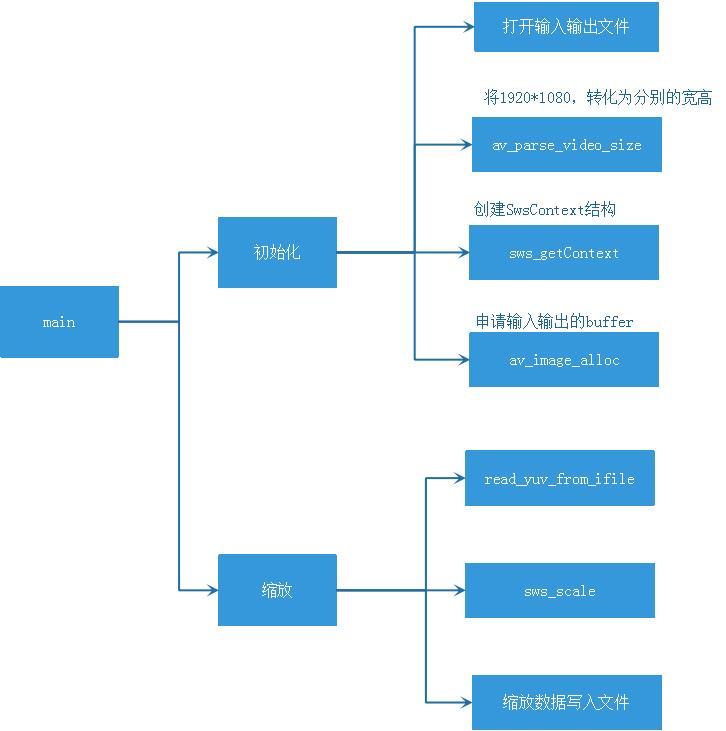FFMpeg SDK使用8调用FFmpeg SDK实现视频缩放
Posted 叮咚咕噜
tags:
篇首语:本文由小常识网(cha138.com)小编为大家整理,主要介绍了FFMpeg SDK使用8调用FFmpeg SDK实现视频缩放相关的知识,希望对你有一定的参考价值。
- 视频缩放:视频内容不变,通过对视频的像素数据进行采样或插值,将画面的分辨率从一种尺寸变换到另一种尺寸。包括低清晰度到高清晰度或者高清晰度到低清晰度
- 视频缩放是视频基本操作之一,可以使视频内容更加适应显示设备的尺寸,提升观看者的体验效果
- libswscale:FFMPEG库,实现视频缩放、颜色空间转换等功能
- swscale操作的对象:视频滤镜针对像素域进行操作,即AVFrame中包含的信息。如果视频以码流的形式保存,则需要先进行解码生成AVFrame
- 处理步骤:

通常情况下视频缩放的主要思想是对视频进行解码到像素域后,针对像素域的像素值进行采样或差值操作。这种方式需要在解码端消耗一定时间,但是通用性最好,不需要对码流格式作出任何特殊处理。在FFMpeg中libswscale库也是针对AVFrame结构进行缩放处理。
0、整体框图

1. 解析命令行参数
输入输出的数据使用以下结构进行封装:
typedef struct _IOFiles
{
char *inputName; //输入文件名
char *outputName; //输出文件名
char *inputFrameSize; //输入图像的尺寸
char *outputFrameSize; //输出图像的尺寸
FILE *iFile; //输入文件指针
FILE *oFile; //输出文件指针
} IOFiles;
输入参数解析过程为:
static bool hello(int argc, char **argv, IOFiles &files)
{
printf("FFMpeg Scaling Demo.\\nCommand format: %s input_file input_frame_size output_file output_frame_size\\n", argv[0]);
if (argc != 5)
{
printf("Error: command line error, please re-check.\\n");
return false;
}
files.inputName = argv[1];
files.inputFrameSize = argv[2];
files.outputName = argv[3];
files.outputFrameSize = argv[4];
fopen_s(&files.iFile, files.inputName, "rb+");
if (!files.iFile)
{
printf("Error: cannot open input file.\\n");
return false;
}
fopen_s(&files.oFile, files.outputName, "wb+");
if (!files.oFile)
{
printf("Error: cannot open output file.\\n");
return false;
}
return true;
}
在参数读入完成后,需要从表示视频分辨率的字符串中解析出图像的宽和高两个值。我们在命令行中传入的视频分辨率字符串的格式为“width x height”,例如”720x480”。解析过程需要调用av_parse_video_size函数。声明如下:
int av_parse_video_size(int *width_ptr, int *height_ptr, const char *str);
例如,我们传入下面的参数:
int frameWidth, frameHeight;
av_parse_video_size(&frameWidth, &frameHeight, "720x480");
函数将分别把720和480传入frameWidth和frameHeight中。
在获取命令行参数后,调用该函数解析图像分辨率:
int srcWidth, srcHeight, dstWidth, dstHeight;
if (av_parse_video_size(&srcWidth, &srcHeight, files.inputFrameSize))
{
printf("Error: parsing input size failed.\\n");
goto end;
}
if (av_parse_video_size(&dstWidth, &dstHeight, files.outputFrameSize))
{
printf("Error: parsing output size failed.\\n");
goto end;
}
这样,我们就获得了源和目标图像的宽和高度。
2. 创建SwsContext结构
进行视频的缩放操作离不开libswscale的一个关键的结构,即SwsContext,该结构提供了缩放操作的必要参数。创建该结构需调用函数sws_getContext。该函数的声明如下:
struct SwsContext *sws_getContext(int srcW, int srcH, enum AVPixelFormat srcFormat,
int dstW, int dstH, enum AVPixelFormat dstFormat,
int flags, SwsFilter *srcFilter,
SwsFilter *dstFilter, const double *param);
该函数的前两行参数分别表示输入和输出图像的宽、高、像素格式,参数flags表示采样和差值使用的算法,常用的有SWS_BILINEAR表示双线性差值等。剩余的不常用参数通常设为NULL。创建该结构的代码如:
//创建SwsContext结构
enum AVPixelFormat src_pix_fmt = AV_PIX_FMT_YUV420P;
enum AVPixelFormat dst_pix_fmt = AV_PIX_FMT_YUV420P;
struct SwsContext *sws_ctx = sws_getContext(srcWidth, srcHeight, src_pix_fmt, dstWidth, dstHeight, dst_pix_fmt, SWS_BILINEAR, NULL,NULL,NULL );
if (!sws_ctx)
{
printf("Error: parsing output size failed.\\n");
goto end;
}
3. 分配像素缓存
视频缩放实际上是在像素域实现,但是实际上我们没有必要真的建立一个个AVFrame对象,我们只需要其像素缓存空间即可,我们定义两个指针数组和两个保存stride的数组,并为其分配内存区域:
//分配input和output
uint8_t *src_data[4], *dst_data[4];
int src_linesize[4], dst_linesize[4];
if ((ret = av_image_alloc(src_data, src_linesize, srcWidth, srcHeight, src_pix_fmt, 32)) < 0)
{
printf(“Error: allocating src image failed.\\n”);
goto end;
}
if ((ret = av_image_alloc(dst_data, dst_linesize, dstWidth, dstHeight, dst_pix_fmt, 1)) < 0)
{
printf(“Error: allocating dst image failed.\\n”);
goto end;
}
4.循环处理输入frame
循环处理的代码为:
//从输出frame中写出到输出文件
int dst_bufsize = ret;
for (int idx = 0; idx < MAX_FRAME_NUM; idx++)
{
read_yuv_from_ifile(src_data, src_linesize, srcWidth, srcHeight, 0, files);
read_yuv_from_ifile(src_data, src_linesize, srcWidth, srcHeight, 1, files);
read_yuv_from_ifile(src_data, src_linesize, srcWidth, srcHeight, 2, files);
sws_scale(sws_ctx, (const uint8_t * const*)src_data, src_linesize, 0, srcHeight, dst_data, dst_linesize);
fwrite(dst_data[0], 1, dst_bufsize, files.oFile);
}
其核心函数为sws_scale,其声明为:
int sws_scale(struct SwsContext *c, const uint8_t *const srcSlice[],
const int srcStride[], int srcSliceY, int srcSliceH,
uint8_t *const dst[], const int dstStride[]);
该函数的各个参数比较容易理解,除了第一个是之前创建的SwsContext之外,其他基本上都是源和目标图像的缓存区和大小等。在写完一帧后,调用fwrite将输出的目标图像写入输出yuv文件中。
5. 收尾工作
收尾工作除了释放缓存区和关闭输入输出文件之外,就是需要释放SwsContext结构,需调用函数:sws_freeContext。实现过程为:
fclose(files.iFile);
fclose(files.oFile);
av_freep(&src_data[0]);
av_freep(&dst_data[0]);
sws_freeContext(sws_ctx);
以上是关于FFMpeg SDK使用8调用FFmpeg SDK实现视频缩放的主要内容,如果未能解决你的问题,请参考以下文章